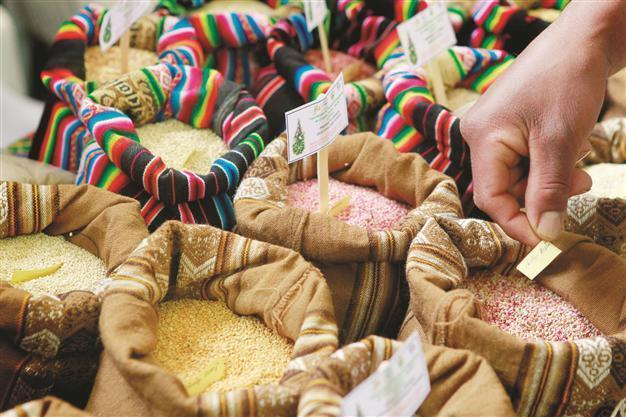Bolivia eyes Mideast, Asia as quinoa market
LA PAZ - Agence France-Presse

Varieties of quinoa, an Andean grain, are tagged by a farmer in Lima. REUTERS photo
Bolivia has its eye on untapped Asian and Middle Eastern markets, hoping to cash in on what the United Nations is calling the International Year of Quinoa, another honor for the Andean “superfood.”Bolivia is the world’s top producer of the super-nutritious “grain” which technically is not a grain but the seeds of the goosefoot plant.
Quinoa, which prospers in semi-arid conditions and high altitudes, is seen as a kind of nutritional superstar. It can be prepared and served like rice but is chock full of protein and essential amino acids.
Originally scorned by Bolivia’s Spanish colonizers, at one point quinoa’s cultivation was banned due to its use in what Spaniards saw as “pagan” ceremonies. The indigenous Incas were forced to grow wheat instead.
Known as chisaya mama or “mother of all grains,” it was so revered by the Incas that the emperor would traditionally sow the first seeds of the season with special tools made out of gold.
But in the past 10-15 years, quinoa (seeds of Chenopodium quinoa) has made major inroads in Western cuisine and is often used as a substitute in pastas, risottos and gratins.
Always on the lookout for healthier options and new tastes, chefs and nutritionists have been wowed by the kitchen versatility of the ancient “grain,” which has a light, fluffy texture and a mild, slightly nutty flavor.
Experts say it has more protein and fiber than rice, corn, wheat or barley -- and fewer carbohydrates than all of them.
Bolivia leads global output -- 70 percent of which is exported -- followed by Peru and Ecuador. Most of Bolivia’s quinoa exports are to the United States and Europe.
“The potential markets now are in Asian countries: China, Japan, Korea... Countries in the Middle East also are interested,” said Ivan Cahuaya, who works with state export promoter Promueve Bolivia.
“We have been selling a lot in mature markets like the United States and Europe, but now the decision is to go find new markets,” said Cahuaya, noting that other countries are boosting their output and some, including Chile, Colombia and the United States, have even sought patents.
With domestic prices having surged and then stabilized, Bolivia is hoping to keep its exports booming.
“We are hoping the International Year of Quinoa, which is 2013, will find us in new markets,” smiled Jaime Belen, of the National Quinoa Growers’ Association.
Quinoa in its natural state has a coating of bitter-tasting saponins, making it unpalatable prior to processing.
Most quinoa sold commercially in North America has been processed to remove this coating, which helps to naturally protect the plant from birds and other predators during the growing process.
















